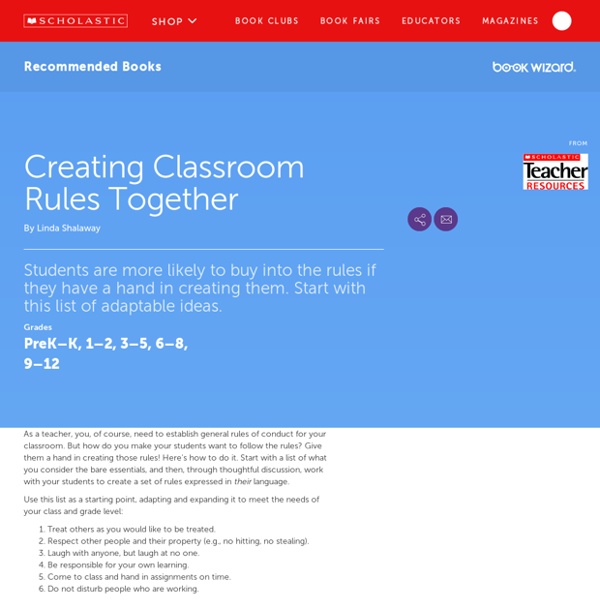Classroom Rules for Teachers
Rules are an important aspect of every classroom, especially when you're working with high school students. Teenagers—with their budding hormones and complex social lives—can be easily distracted, and though many are mature and highly capable, they can still benefit from structure and rules. Key Takeaways: Classroom Rules for High School Students Classroom rules provide the structure and guidelines needed to create a productive learning environment.You can create a set of classroom rules yourself or solicit input from your students and work together to make a list of rules. Creating Effective Classroom Rules
Why I Don’t Have Classroom Rules
However, while I was clearing my credential, working with mentor teachers to reflect on my practice, and finding out how real students differed from theoretical ones, I also spent long hours after school with the speech and debate team reading philosophy and theory and talking about innovative alternatives for national defense, natural resource allocation, and, of course, education. That led me to some uncomfortable conclusions. Although I encouraged my students to think critically and challenged myself to develop new methods of instruction, the actual conduct of the class seemed at odds with all that. I wanted my students to do more than just follow rules handed down to them.
Sample Classroom Rules for Teachers
When designing your classroom rules, keep in mind that your rules must be clear, comprehensive, and enforceable. And then comes the most important part... you must be consistent in enforcing them all the time, with every student, using predictable and delineated consequences. Some teachers suggest writing the class rules with your students, using their input to create "buy-in" and cooperation. Consider the benefits of strong, teacher-determined rules that are not viewed as negotiable by the people who must follow them.
Our Class Rules
The poster below can be used on a display in your classroom to share your expectations with your class. It is editable so you can add your own rules (although you are welcome to keep our suggestions too). Why not use it at the start of the school year and ask children to come up with their own list of suggested rules? Here are some rules that you could include: Listen to the teacher / adult. Listen to others.
Our Class Rules
The poster below can be used on a display in your classroom to share your expectations with your class. It is editable so you can add your own rules (although you are welcome to keep our suggestions too). Why not use it at the start of the school year and ask children to come up with their own list of suggested rules?
A Classroom Management Plan for You
Classroom Management Plan Rules Imagine a basketball game in which none of the players know the rules. The referees would blow the whistle constantly, admonishing players for breaking rules they didn’t know existed. How frustrating would this game be for both the players and the refs, and for the fans in the bleachers? It would be chaos.
Establishing Classroom Rules
By Phil Nast, retired middle school teacher and freelance writer Found In: Classroom Management Appropriate behavior fosters a positive classroom environment. Engaging students on the first day of school in creating of a set of rules helps ensure their investment. The following professional development resources, articles, and activities offer different approaches to this common start of school task. Professional Development
List of Classroom Rules
Establishing a set of classroom rules on your first day back to school will set the tone for a productive new school year. Pick 5-10 classroom rules from the big list below that would best fit your students. Write down your main classroom rules on a chart and hang the rules in a highly visible area of the classroom.
30 Classroom Procedures to Head Off Behavior Problems
The secret to warding off at least some behavior problems is establishing positive classroom procedures for daily tasks and activities. Your students will appreciate your consistency, and once they have internalized classroom procedures, the day will run that much more smoothly. Of course, choosing the right rules and procedures for your classroom is an individual decision. But be sure to define what you expect of students from the very beginning.
The Art of Control
Executive function — our ability to remember and use what we know, defeat our unproductive impulses, and switch gears and adjust to new demands — is increasingly understood as a key element not just of learning but of lifelong success. Researchers at the Center on the Developing Child at Harvard University describe executive function as an air traffic control system for the mind — helping us manage streams of information, revise plans, stay organized, filter out distractions, cope with stress, and make healthy decisions. Children learn these skills first from their parents, through reliable routines, meaningful and responsive interactions, and play that focuses attention and stirs the beginnings of self-control.
Top 10 Classroom Rules for Elementary School Students
Classroom rules are important to your class community. When students have rules, they know what your expectations are for them. They know what you want them to do, and they know that there are consequences for failing to follow the rules.
Elementary Classroom Rules and Management by Leah Davies, M.Ed.
By Leah Davies, M.Ed. Elementary classrooms can become better learning environments when teachers have rules, classroom management skills, and a belief that each child can be successful. Rules help create a predictable atmosphere that limit classroom disruptions and encourage children to use self-control. Children need to be taught that it is their responsibility to make appropriate choices and that they will be held accountable for their actions.



